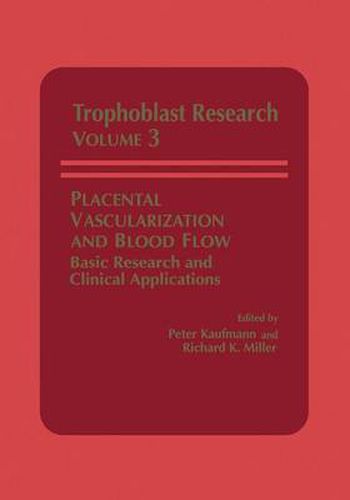Readings Newsletter
Become a Readings Member to make your shopping experience even easier.
Sign in or sign up for free!
You’re not far away from qualifying for FREE standard shipping within Australia
You’ve qualified for FREE standard shipping within Australia
The cart is loading…






This title is printed to order. This book may have been self-published. If so, we cannot guarantee the quality of the content. In the main most books will have gone through the editing process however some may not. We therefore suggest that you be aware of this before ordering this book. If in doubt check either the author or publisher’s details as we are unable to accept any returns unless they are faulty. Please contact us if you have any questions.
The optimal function of the placenta and thus fetal well being largely depends upon the integrity of both the fetal and maternal circulations of the placenta. Intense basic research concerned with placental vascularization and blood flow has been performed for the past 30 years, beginning with the classical morphological descriptions of the placental vessels by Boe (1953) and Arts (1961), as well as with the radioangiographic studies of maternal placental circulation in the human by Borell (1958) and in the rhesus monkey by Ramsey (1962). The scientific framework presented by these investigators has been filled and completed by numerous investigators, leading to more morphological details, functional considerations, and pathological understanding. For an extended period of time, this research has been of primarily academic interest by increasing our insights into one important system of the placenta, yet having nearly no practical importance. Recently, this situation has changed dramatically: in vitro studies of the isolated, dually perfused human placenta and in vivo studies of placental circulation for diagnostic purposes have raised an enormous interest in basic research data. New methods like Doppler Ultrasound and NMR became available. These technics have enabled the obstetrician to study fetal and placental hemodynamics in vivo. Meanwhile, such methods are becoming incorporated into the daily obstetrical routine, to some degree without an adequate background knowledge of placental vascularization and blood flow, since such experience is currently available to only a small group of experts.
$9.00 standard shipping within Australia
FREE standard shipping within Australia for orders over $100.00
Express & International shipping calculated at checkout
This title is printed to order. This book may have been self-published. If so, we cannot guarantee the quality of the content. In the main most books will have gone through the editing process however some may not. We therefore suggest that you be aware of this before ordering this book. If in doubt check either the author or publisher’s details as we are unable to accept any returns unless they are faulty. Please contact us if you have any questions.
The optimal function of the placenta and thus fetal well being largely depends upon the integrity of both the fetal and maternal circulations of the placenta. Intense basic research concerned with placental vascularization and blood flow has been performed for the past 30 years, beginning with the classical morphological descriptions of the placental vessels by Boe (1953) and Arts (1961), as well as with the radioangiographic studies of maternal placental circulation in the human by Borell (1958) and in the rhesus monkey by Ramsey (1962). The scientific framework presented by these investigators has been filled and completed by numerous investigators, leading to more morphological details, functional considerations, and pathological understanding. For an extended period of time, this research has been of primarily academic interest by increasing our insights into one important system of the placenta, yet having nearly no practical importance. Recently, this situation has changed dramatically: in vitro studies of the isolated, dually perfused human placenta and in vivo studies of placental circulation for diagnostic purposes have raised an enormous interest in basic research data. New methods like Doppler Ultrasound and NMR became available. These technics have enabled the obstetrician to study fetal and placental hemodynamics in vivo. Meanwhile, such methods are becoming incorporated into the daily obstetrical routine, to some degree without an adequate background knowledge of placental vascularization and blood flow, since such experience is currently available to only a small group of experts.